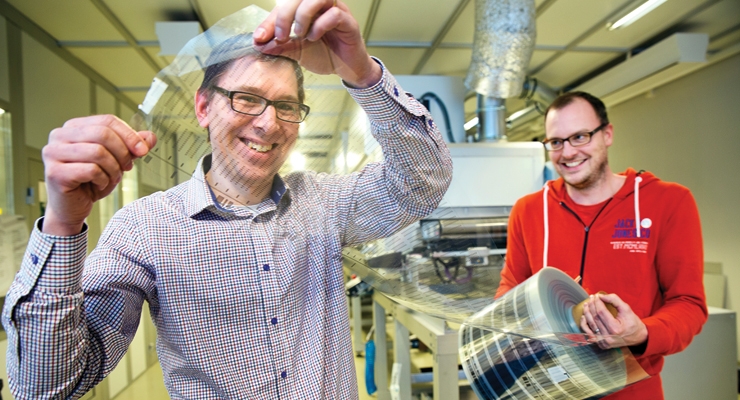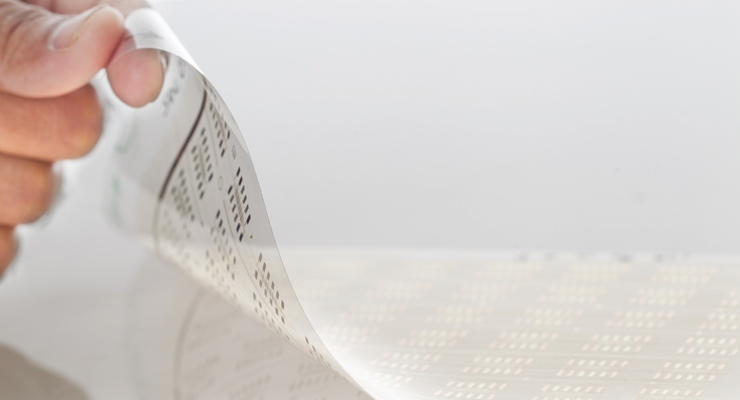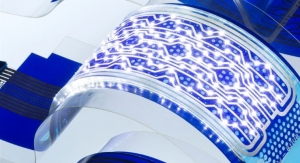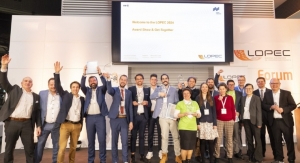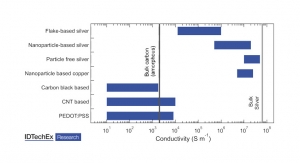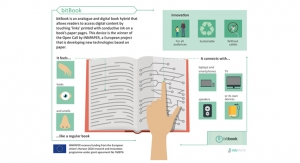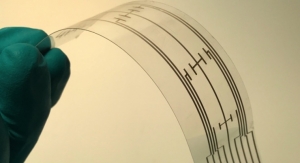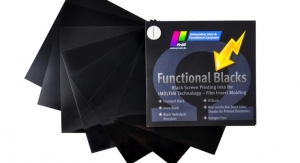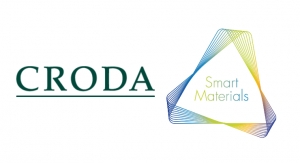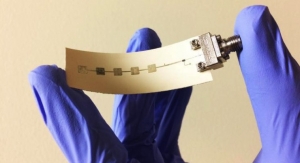Dave Savastano, Editor03.09.15
The lure of flexible and printed electronics has captured the attention of researchers and entrepreneurs alike, but it hasn’t translated to the market yet. Still, the idea of low cost functional flexible systems such as sensors, wearables and smart packaging that can be mass produced is attractive for many markets.
It appears that more products are in the pipeline, and flexible and printed electronics are starting to fulfill their promise.
“The market for printed and flexible electronics is set to reach over $73 billion by 2025, as explained in detail in the flagship IDTechEx report on the topic, Printed, Organic & Flexible Electronics Forecasts, Players & Opportunities 2015-2025,” said Dr. Harry Zervos, principal analyst and business development manager for North America for IDTechEx. “Not all separate types of printed electronics will share equally in that big market – as I always say, printed electronics is an umbrella term and some markets will reach maturity sooner than others – but already, OLEDs, conductive inks in PV applications and printed glucose sensors are billion dollar markets that are set to grow.”
“We are beginning to see more market pull for printed electronics,” said Jennifer Ernst, Thin Film Electronics’ (Thinfilm) chief strategy officer. “There are several reasons why this is happening.
“As the Internet of Things (IoT) moves from hype to action, low-cost and lightweight technology for ubiquitous sensing, secure storage and transmission of data will be essential,” Ernst noted. “This has opened up a whole new market for printed electronics. Printed memory, sensors and communications devices will be an essential part of the IoT ecosystem with its revenue potential expected to reach $7.1 trillion by 2020, according to research firm IDC.”
In significant news, Thinfilm and Xerox announced in January 2015 a manufacturing partnership, in which Xerox will manufacture Thinfilm’s Memory labels.
“On the manufacturing front, Thinfilm is prepared to scale up production to meet the demands of market adoption,” Ernst said. “We have just entered a strategic partnership with Xerox, a global business services leader. As a core element of the agreement, Xerox has licensed Thinfilm’s proprietary technology to manufacture Thinfilm Memory labels. In addition, Xerox will develop a marketing strategy targeted to key customers.
To produce the memory labels, Xerox will modify a production line in one of its existing facilities in Webster NY.
Heidi Hoffman, director, FlexTech Alliance, said that the flexible and printed electronics market “has been a true roller coaster – lots of curves, deceleration and acceleration. Now, we are in a good spot with applications emerging and a supply chain ready to provide tools and materials. Wearable, medical and product packaging are the markets we hear about most.
“Thin Film’s multiple product announcements – recently the partnership announcement with Xerox for memory labels – exemplifies the component integration that is quite exciting,” Hoffman added.
Jaye Tyler, president and CEO of Si-Cal Technologies Inc., A Nissha Company, specializes in printing functional printed electronics (PE) components, primarily in the medical field. Tyler said it takes time to get new products approved, but products are now getting the OK.
“The printed electronics development cycle can be very long and frustrating, but now we are seeing major programs going to manufacturing,” said Tyler.
“The industry for organic and printed electronics can look to the future optimistically,” Wolfgang Mildner, LOPEC general chair, said. “The OE-A is predicting an increase in sales revenue of 19% in 2015. This means that all signs point to growth as the second OE-A business climate survey found.”
The ability to produce hundreds of millions of low cost, highly functional tags has captured the eye of brand owners, particularly in temperature-sensitive fields such as food and pharmaceuticals.
“Smart packaging is becoming more of a safety requirement than just a marketing tactic,” Ernst said. “For instance, as the FDA and other government organizations increase the regulations associated with food and pharmaceuticals, the need to track and monitor these items’ increases accordingly. Printed sensors and displays are a natural fit for this application. They provide a clear indication of whether or not an item has exceeded its temperature threshold. The price of a printed sensor is cost-effective enough that it is feasible to implement at the item level, ensuring that the temperature is being monitored directly on the product.”
Scott White is CEO of PragmatIC Printing, which enables printed electronic logic circuits that introduce intelligence and interactivity into a wide range of products and applications. The company just received more than $5 million in funding, which will enable the scale-up of its production capacity to 100 million flexible integrated circuits. White said that he is seeing two main types of applications.
“First, there are new applications enabled by flexible electronics that were not previously viable using conventional electronics,” White said. “This includes, for example, many types of smart packaging. These applications have huge potential, but are developing slowly since they require our customers to develop a complete business case and get comfortable with the entire supply chain that would deliver them.
“Second, there are existing applications that can be made more compelling or cost-effective with flexible electronics,” White continued. “The most obvious example here is RFID, which can be delivered using silicon-based tags but cannot reduce cost far enough to enable item-level tagging. These kinds of applications have proven (and still growing) market opportunities, but generally need more scale and maturity in the manufacturing chain in order to achieve the potential cost reductions offered by flexible electronics.
Dr. Joshua Windmiller, CEO of Electrozyme LLC, which develops biosensors, said that we are living in very exciting times for the flexible and printed electronics (FPE) fields.
“We are still in the early days of printed electronics,” said Dr. Windmiller. “Although traditionally a niche domain within the greater electronics arena, flexible and printed electronics (FPE) has branched out to disparate lines of industry and the most exciting applications in the field are highly multi-disciplinary in nature, lying at the intersection of materials science, electrical engineering and mechanical engineering disciplines, among others. Opportunities abound to augment and capitalize on the momentum and convergence that we are witnessing in this exciting area.”
Wearables are another area of interest in flexible and printed electronics. Dr. Zervos said that there has been a significant rise in the interest in flexible electronics, mainly driven from two trends. The first is the introduction of the first flexible displays for consumer electronics from LG and Samsung. The second is an increased interest in wearables, which will benefit significantly in the long term from introduction of non-rigid components and devices, which will of course will be much easier to integrate, due to the flexibility in form factor.
“A good example of flexible electronics for wearables include Futaba’s passive matrix flexible OLED displays for wristbands, which have already been incorporated in at least two different wristbands so far (from Huawei and Garmin),” Zervos said. “These are the most visible examples, and along with an increased interest in flexible thin batteries (which are still struggling to increase power output but are slowly improving) and flexible sensors, are examples of a market in motion, set for significant growth in the next few years.”
CYNORA focuses is making Singlet Harvesting technology available for OLEDs, adapting the materials for solution processing. A CYNORA official said that the company sees growth in the field of flexible as well as printed electronics.
“As examples for flexible electronics, there are new bendable smartphones coming up, wearable devices are becoming more popular and even for OLED lighting there are large players who focus on developing flexible and lightweight panels,” the CYNORA official added. “Printed electronics still is going to require a significant period of time until it will be applied for mass applications, but it already is applied for particular challenges where extremely short development and product realization periods are mandatory.”
Anti-counterfeiting and brand protection are also key markets for Thinfilm.
“While temperature threshold monitoring continues to be a key market for printed electronics, we are starting to see traction with brand protection and anti-counterfeiting in retail applications as well,” Ernst noted. “In 2014, Thinfilm and Temptime collaborated to deliver printed electronic temperature indicators for use in distribution, storage and management of sensitive medical products. Also in 2014, Thinfilm announced a commercial distribution agreement with PakSense, Inc., a market leader in the development of intelligent sensing products specifically designed to monitor perishable goods.
“On the retail side, we received a follow-up volume production order for our electronic article surveillance (EAS) labels in December. The EAS labels are the first of Thinfilm’s commercial products to contain radio-frequency (RF) functionality. The order is a part of a worldwide rollout for an international end-customer who is a global leader in their field. The ordered volume totals 13 million units and is to be delivered primarily during the first three quarters of 2015. This past December, Thinfilm also announced that Global Factories, the global market leader in the field of medicine pouch verification, will use Thinfilm printed memory labels for security and authentication in its new Vandenbrink Blister Packaging Machine (VBM).”
Near field communication (NFC) is a strong opportunity, and Thinfilm has developed tags utilizing NFC.
“We believe NFC is here to stay, and that it is the lowest-power, lowest-cost way to connect smart objects to smartphones. Thinfilm has pioneered a combination of NFC with sensing that goes beyond ordinary static IDs,” Ernst said. “These dynamic smart tags will make intelligence everywhere powerful, and by using printing techniques, immensely scalable. As mobile providers move beyond today’s bandwidth monetization model into more application-centric models, use cases that take advantage of the security and ease-of-use that NFC provides will create even more market pull for low-cost, flexible printed electronics.
“We are very proud of the progress we’ve made with our RF portfolio, including our NFC Barcode product,” Ernst added. “The Barcode can be used in conjunction with EVRYTHNG’s cloud-based marketing and analytics engine through NFC-enabled mobile phones and tablets. The NFC Barcode will address a wide range of important markets, such as healthcare, manufacturing and consumer goods for applications such as brand authentication, grey-market (diversion) detection, mobile marketing, asset management and track-and-trace monitoring.
“Also, Thinfilm’s NFC Smart Label platform combined with EVRYTHNG’s software will enable organizations to address markets in which globally unique identifiers are combined with real-time sensor data to add a new dimension to mobile data collection and user interactivity,” Ernst noted. “Temperature sensing labels, for example, can be used to monitor shipments of vaccines, insulin and other sensitive pharmaceuticals. On the ground, mobile devices provide a real-time window to product batch information and temperature conditions, while scanned data is simultaneously pushed to the cloud to enable analysis and reporting of actionable insights.”
American Semiconductor specializes in flexible integrated circuits and flexible hybrid systems development. Douglas Hackler, American Semiconductor’s president, said that American Semiconductor is seeing a lot of growth in interest. “However, a mainstream flexible electronic product has not yet emerged,” Hackler added. “While a lot of technology has been developed, the ability to integrate the various interconnect, sensor and device components still seems to be a challenge.”
Dr. Malcolm G. Keif, professor and graduate coordinator printed electronics and functional imaging for Cal Poly State University’s Graphic Communication Department, has been involved in many of the demonstrators seen at conferences. He said that Cal Poly is seeing growth in the field of flexible and printed electronics.
“We continue to see new and interesting applications for printed and hybrid electronics,” Dr. Keif reported. “The key drivers are flexibility and light-weighting. We see small pockets of growth in the private sector too. New products are being launched every day.”
This is quite a change from even a decade ago, when printed electronics was an R&D exercise.
“Looking at the past 10 years, the most important development definitely is that printed electronics has actually become a market – 10 years ago, printed electronics was an R&D field,” Mildner said. “Now, quite a few products have left the lab, investments in production have been made and products can be found in applications. Of course, we already saw great opportunities 10 years ago and we continue to see them. But some of them have become reality.”
Peter Kallai, executive director of the Canadian Printable Electronics Industry Association, said that the flexible and printed electronics market has become more focused on applications for actual end users during the past 10 years.
“Getting out of the gate, it was based on what is possible,” Kallai said. “Now it is turning into mainstream, although it is not fully there yet, and saying what will be required by the end users.”
The Future for Flexible and Printed Electronics
Throughout the flexible and printed electronics supply chain, there is optimism about the new products and applications reaching the market.
“In the past few years, the industry has witnessed itself transition from infancy to early adolescence, with marked growth in such domains as healthcare, display technology, sensors and wearable technology, to name a few,” Dr. Windmiller said. “Although FPE will continue to occupy its own niche for some time, new generations of wearable and skin-conformal devices are beginning to materialize that offer consumers novel capabilities or, at the very least, compelling value propositions over their solid-state counterparts.
“Moreover, new business models are beginning to emerge that aim at exploiting opportunities for generating recurring revenue from the sale of disposable flexible and/or printed components,” Dr.. Windmiller added. “As an example, flexible skin-worn patches containing printed electronics intended for various medical applications are challenging the conventional notion that high-margins are requisite for medical devices. Such epidermal patches can be worn and disposed of on a weekly basis, after which a new patch is adhered to the skin.”
Ernst said that Thinfilm sees two key advances that will push printed electronics further into the mainstream.
“First, continued scaling of printed electronics manufacturing processes will be critical.,” Ernst said. “Additional technology development and further advancement in manufacturing techniques will be required to enhance the capabilities of printed electronics and smart systems. Printer companies, materials companies and companies that can integrate capabilities must work together to facilitate the growth of this market.
“Second, leading market analysts Gartner and IDC agree that development of intelligent software platforms – similar to the cloud-based system provided by our partner, EVRYTHNG – is essential to grow the IoT market and to enable interaction with printed smart labels and other printed electronics,” Ernst said. “In addition to a software interface, the amount of data generated will require algorithms to analyze the information and new business processes are needed to effectively utilize the information garnered with printed electronics.”
Ernst added that in the near term, most applications for printed electronics will be closed loop or semi-closed loop, with a move toward open-loop applications emerging in the medium term.
“Examples of closed loop applications include track-and-trace for consumer goods, medication/vaccine logistics, especially where temperature monitoring is concerned, and industrial applications for auditing or inventory control,” Ernst noted. “Medium-term we expect to see more penetration into open-loop applications. We’ve already seen implementation of printed electronics for anti-counterfeiting measures in luxury goods and clothing. Other examples of open-loop applications include interactive marketing for consumer goods and grocery items. Wearable items such as bandages or body sensors also show great promise.
“While the life cycle of these types of goods (i.e., produce, medications) may be short compared with other items, the ability to incorporate sensing, data storage and connectivity for these endpoints can provide invaluable information to many parts of the supply chain – such as reduction in food spoilage, informing consumers of key attributes of a product’s life cycle, or adhering to regulatory requirements,” Ernst concluded.
It appears that more products are in the pipeline, and flexible and printed electronics are starting to fulfill their promise.
“The market for printed and flexible electronics is set to reach over $73 billion by 2025, as explained in detail in the flagship IDTechEx report on the topic, Printed, Organic & Flexible Electronics Forecasts, Players & Opportunities 2015-2025,” said Dr. Harry Zervos, principal analyst and business development manager for North America for IDTechEx. “Not all separate types of printed electronics will share equally in that big market – as I always say, printed electronics is an umbrella term and some markets will reach maturity sooner than others – but already, OLEDs, conductive inks in PV applications and printed glucose sensors are billion dollar markets that are set to grow.”
“We are beginning to see more market pull for printed electronics,” said Jennifer Ernst, Thin Film Electronics’ (Thinfilm) chief strategy officer. “There are several reasons why this is happening.
“As the Internet of Things (IoT) moves from hype to action, low-cost and lightweight technology for ubiquitous sensing, secure storage and transmission of data will be essential,” Ernst noted. “This has opened up a whole new market for printed electronics. Printed memory, sensors and communications devices will be an essential part of the IoT ecosystem with its revenue potential expected to reach $7.1 trillion by 2020, according to research firm IDC.”
In significant news, Thinfilm and Xerox announced in January 2015 a manufacturing partnership, in which Xerox will manufacture Thinfilm’s Memory labels.
“On the manufacturing front, Thinfilm is prepared to scale up production to meet the demands of market adoption,” Ernst said. “We have just entered a strategic partnership with Xerox, a global business services leader. As a core element of the agreement, Xerox has licensed Thinfilm’s proprietary technology to manufacture Thinfilm Memory labels. In addition, Xerox will develop a marketing strategy targeted to key customers.
To produce the memory labels, Xerox will modify a production line in one of its existing facilities in Webster NY.
Heidi Hoffman, director, FlexTech Alliance, said that the flexible and printed electronics market “has been a true roller coaster – lots of curves, deceleration and acceleration. Now, we are in a good spot with applications emerging and a supply chain ready to provide tools and materials. Wearable, medical and product packaging are the markets we hear about most.
“Thin Film’s multiple product announcements – recently the partnership announcement with Xerox for memory labels – exemplifies the component integration that is quite exciting,” Hoffman added.
Jaye Tyler, president and CEO of Si-Cal Technologies Inc., A Nissha Company, specializes in printing functional printed electronics (PE) components, primarily in the medical field. Tyler said it takes time to get new products approved, but products are now getting the OK.
“The printed electronics development cycle can be very long and frustrating, but now we are seeing major programs going to manufacturing,” said Tyler.
“The industry for organic and printed electronics can look to the future optimistically,” Wolfgang Mildner, LOPEC general chair, said. “The OE-A is predicting an increase in sales revenue of 19% in 2015. This means that all signs point to growth as the second OE-A business climate survey found.”
The ability to produce hundreds of millions of low cost, highly functional tags has captured the eye of brand owners, particularly in temperature-sensitive fields such as food and pharmaceuticals.
“Smart packaging is becoming more of a safety requirement than just a marketing tactic,” Ernst said. “For instance, as the FDA and other government organizations increase the regulations associated with food and pharmaceuticals, the need to track and monitor these items’ increases accordingly. Printed sensors and displays are a natural fit for this application. They provide a clear indication of whether or not an item has exceeded its temperature threshold. The price of a printed sensor is cost-effective enough that it is feasible to implement at the item level, ensuring that the temperature is being monitored directly on the product.”
Scott White is CEO of PragmatIC Printing, which enables printed electronic logic circuits that introduce intelligence and interactivity into a wide range of products and applications. The company just received more than $5 million in funding, which will enable the scale-up of its production capacity to 100 million flexible integrated circuits. White said that he is seeing two main types of applications.
“First, there are new applications enabled by flexible electronics that were not previously viable using conventional electronics,” White said. “This includes, for example, many types of smart packaging. These applications have huge potential, but are developing slowly since they require our customers to develop a complete business case and get comfortable with the entire supply chain that would deliver them.
“Second, there are existing applications that can be made more compelling or cost-effective with flexible electronics,” White continued. “The most obvious example here is RFID, which can be delivered using silicon-based tags but cannot reduce cost far enough to enable item-level tagging. These kinds of applications have proven (and still growing) market opportunities, but generally need more scale and maturity in the manufacturing chain in order to achieve the potential cost reductions offered by flexible electronics.
Dr. Joshua Windmiller, CEO of Electrozyme LLC, which develops biosensors, said that we are living in very exciting times for the flexible and printed electronics (FPE) fields.
“We are still in the early days of printed electronics,” said Dr. Windmiller. “Although traditionally a niche domain within the greater electronics arena, flexible and printed electronics (FPE) has branched out to disparate lines of industry and the most exciting applications in the field are highly multi-disciplinary in nature, lying at the intersection of materials science, electrical engineering and mechanical engineering disciplines, among others. Opportunities abound to augment and capitalize on the momentum and convergence that we are witnessing in this exciting area.”
“A good example of flexible electronics for wearables include Futaba’s passive matrix flexible OLED displays for wristbands, which have already been incorporated in at least two different wristbands so far (from Huawei and Garmin),” Zervos said. “These are the most visible examples, and along with an increased interest in flexible thin batteries (which are still struggling to increase power output but are slowly improving) and flexible sensors, are examples of a market in motion, set for significant growth in the next few years.”
CYNORA focuses is making Singlet Harvesting technology available for OLEDs, adapting the materials for solution processing. A CYNORA official said that the company sees growth in the field of flexible as well as printed electronics.
“As examples for flexible electronics, there are new bendable smartphones coming up, wearable devices are becoming more popular and even for OLED lighting there are large players who focus on developing flexible and lightweight panels,” the CYNORA official added. “Printed electronics still is going to require a significant period of time until it will be applied for mass applications, but it already is applied for particular challenges where extremely short development and product realization periods are mandatory.”
Anti-counterfeiting and brand protection are also key markets for Thinfilm.
“While temperature threshold monitoring continues to be a key market for printed electronics, we are starting to see traction with brand protection and anti-counterfeiting in retail applications as well,” Ernst noted. “In 2014, Thinfilm and Temptime collaborated to deliver printed electronic temperature indicators for use in distribution, storage and management of sensitive medical products. Also in 2014, Thinfilm announced a commercial distribution agreement with PakSense, Inc., a market leader in the development of intelligent sensing products specifically designed to monitor perishable goods.
“On the retail side, we received a follow-up volume production order for our electronic article surveillance (EAS) labels in December. The EAS labels are the first of Thinfilm’s commercial products to contain radio-frequency (RF) functionality. The order is a part of a worldwide rollout for an international end-customer who is a global leader in their field. The ordered volume totals 13 million units and is to be delivered primarily during the first three quarters of 2015. This past December, Thinfilm also announced that Global Factories, the global market leader in the field of medicine pouch verification, will use Thinfilm printed memory labels for security and authentication in its new Vandenbrink Blister Packaging Machine (VBM).”
Near field communication (NFC) is a strong opportunity, and Thinfilm has developed tags utilizing NFC.
“We believe NFC is here to stay, and that it is the lowest-power, lowest-cost way to connect smart objects to smartphones. Thinfilm has pioneered a combination of NFC with sensing that goes beyond ordinary static IDs,” Ernst said. “These dynamic smart tags will make intelligence everywhere powerful, and by using printing techniques, immensely scalable. As mobile providers move beyond today’s bandwidth monetization model into more application-centric models, use cases that take advantage of the security and ease-of-use that NFC provides will create even more market pull for low-cost, flexible printed electronics.
“We are very proud of the progress we’ve made with our RF portfolio, including our NFC Barcode product,” Ernst added. “The Barcode can be used in conjunction with EVRYTHNG’s cloud-based marketing and analytics engine through NFC-enabled mobile phones and tablets. The NFC Barcode will address a wide range of important markets, such as healthcare, manufacturing and consumer goods for applications such as brand authentication, grey-market (diversion) detection, mobile marketing, asset management and track-and-trace monitoring.
“Also, Thinfilm’s NFC Smart Label platform combined with EVRYTHNG’s software will enable organizations to address markets in which globally unique identifiers are combined with real-time sensor data to add a new dimension to mobile data collection and user interactivity,” Ernst noted. “Temperature sensing labels, for example, can be used to monitor shipments of vaccines, insulin and other sensitive pharmaceuticals. On the ground, mobile devices provide a real-time window to product batch information and temperature conditions, while scanned data is simultaneously pushed to the cloud to enable analysis and reporting of actionable insights.”
American Semiconductor specializes in flexible integrated circuits and flexible hybrid systems development. Douglas Hackler, American Semiconductor’s president, said that American Semiconductor is seeing a lot of growth in interest. “However, a mainstream flexible electronic product has not yet emerged,” Hackler added. “While a lot of technology has been developed, the ability to integrate the various interconnect, sensor and device components still seems to be a challenge.”
Dr. Malcolm G. Keif, professor and graduate coordinator printed electronics and functional imaging for Cal Poly State University’s Graphic Communication Department, has been involved in many of the demonstrators seen at conferences. He said that Cal Poly is seeing growth in the field of flexible and printed electronics.
“We continue to see new and interesting applications for printed and hybrid electronics,” Dr. Keif reported. “The key drivers are flexibility and light-weighting. We see small pockets of growth in the private sector too. New products are being launched every day.”
This is quite a change from even a decade ago, when printed electronics was an R&D exercise.
“Looking at the past 10 years, the most important development definitely is that printed electronics has actually become a market – 10 years ago, printed electronics was an R&D field,” Mildner said. “Now, quite a few products have left the lab, investments in production have been made and products can be found in applications. Of course, we already saw great opportunities 10 years ago and we continue to see them. But some of them have become reality.”
Peter Kallai, executive director of the Canadian Printable Electronics Industry Association, said that the flexible and printed electronics market has become more focused on applications for actual end users during the past 10 years.
“Getting out of the gate, it was based on what is possible,” Kallai said. “Now it is turning into mainstream, although it is not fully there yet, and saying what will be required by the end users.”
The Future for Flexible and Printed Electronics
Throughout the flexible and printed electronics supply chain, there is optimism about the new products and applications reaching the market.
“In the past few years, the industry has witnessed itself transition from infancy to early adolescence, with marked growth in such domains as healthcare, display technology, sensors and wearable technology, to name a few,” Dr. Windmiller said. “Although FPE will continue to occupy its own niche for some time, new generations of wearable and skin-conformal devices are beginning to materialize that offer consumers novel capabilities or, at the very least, compelling value propositions over their solid-state counterparts.
“Moreover, new business models are beginning to emerge that aim at exploiting opportunities for generating recurring revenue from the sale of disposable flexible and/or printed components,” Dr.. Windmiller added. “As an example, flexible skin-worn patches containing printed electronics intended for various medical applications are challenging the conventional notion that high-margins are requisite for medical devices. Such epidermal patches can be worn and disposed of on a weekly basis, after which a new patch is adhered to the skin.”
Ernst said that Thinfilm sees two key advances that will push printed electronics further into the mainstream.
“First, continued scaling of printed electronics manufacturing processes will be critical.,” Ernst said. “Additional technology development and further advancement in manufacturing techniques will be required to enhance the capabilities of printed electronics and smart systems. Printer companies, materials companies and companies that can integrate capabilities must work together to facilitate the growth of this market.
“Second, leading market analysts Gartner and IDC agree that development of intelligent software platforms – similar to the cloud-based system provided by our partner, EVRYTHNG – is essential to grow the IoT market and to enable interaction with printed smart labels and other printed electronics,” Ernst said. “In addition to a software interface, the amount of data generated will require algorithms to analyze the information and new business processes are needed to effectively utilize the information garnered with printed electronics.”
Ernst added that in the near term, most applications for printed electronics will be closed loop or semi-closed loop, with a move toward open-loop applications emerging in the medium term.
“Examples of closed loop applications include track-and-trace for consumer goods, medication/vaccine logistics, especially where temperature monitoring is concerned, and industrial applications for auditing or inventory control,” Ernst noted. “Medium-term we expect to see more penetration into open-loop applications. We’ve already seen implementation of printed electronics for anti-counterfeiting measures in luxury goods and clothing. Other examples of open-loop applications include interactive marketing for consumer goods and grocery items. Wearable items such as bandages or body sensors also show great promise.
“While the life cycle of these types of goods (i.e., produce, medications) may be short compared with other items, the ability to incorporate sensing, data storage and connectivity for these endpoints can provide invaluable information to many parts of the supply chain – such as reduction in food spoilage, informing consumers of key attributes of a product’s life cycle, or adhering to regulatory requirements,” Ernst concluded.

